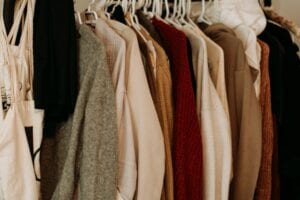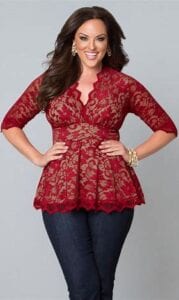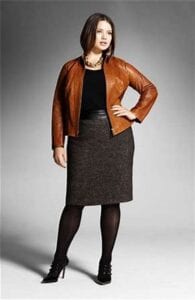 Most of us have never been taught how to dress for our features – our skin, hair and eye colors, our body shape and proportions and our face shape. Instead, we just buy clothes we can afford in styles and colors we like and that the fashion industry tells us is “in”. We end up with a closet full of clothes that don’t mix and match, feeling like we have nothing to wear.
Most of us have never been taught how to dress for our features – our skin, hair and eye colors, our body shape and proportions and our face shape. Instead, we just buy clothes we can afford in styles and colors we like and that the fashion industry tells us is “in”. We end up with a closet full of clothes that don’t mix and match, feeling like we have nothing to wear.
All this makes the mere act of getting dressed a frustrating experience. We try on multiple outfits, hoping something works, only to end up wearing that same one or two outfits we always choose because for some reason they look particularly good. Sound familiar?
Dressing for Illusion
Like most things, dressing for our individual coloring, body type, proportions and face shape is a learned skill. When you do this, your clothes fit well, are in styles that minimize body areas you want to hide while playing up your attributes, and are in tones that flatter your skin, hair and eye coloring, giving you a healthy look. You just look good.
The first thing you need to know is what color tones look good on you. If you haven’t done that, click here. Second, you need to know where to put color, or not put color, to intentionally draw the eye toward or away from parts of your body. This is called Dressing for Illusion. It’s an important step in learning about how you put outfits together.
Determine What You Want to Emphasize
Where you put color on your body determines what others will notice. Do you have great shoulders? Love your legs? Have a great bust line or slender waist? The human eye is drawn to the lightest or brightest colors and to color breaks in your clothing. Patterns, particularly large ones, draw attention, as do embellishments such as large pockets, beading, lace, scarfs and jewelry. Darker colors are slimming and are best worn to diminish areas that you don’t want noticed.
 Look at the woman in the photo to the right. What do you notice first? What do you notice second? Most likely you first noticed her blouse and her face. That’s because her blouse is brighter than her dark blue jeans, which fade to the background against her blouse. The distinctive neckline and lace of the blouse add to bringing your eye up because that is where the activity is happening. You might have then noticed the point at which her blouse meets the jeans, bringing the attention to her hips. That’s because the eye is drawn to the color break there.
Look at the woman in the photo to the right. What do you notice first? What do you notice second? Most likely you first noticed her blouse and her face. That’s because her blouse is brighter than her dark blue jeans, which fade to the background against her blouse. The distinctive neckline and lace of the blouse add to bringing your eye up because that is where the activity is happening. You might have then noticed the point at which her blouse meets the jeans, bringing the attention to her hips. That’s because the eye is drawn to the color break there.
This combination works great for this beautiful lady because of her Hourglass build. She is emphasizing her asset areas of her slender shoulders and waist and healthy bust line while minimizing her wider hips and thighs. If she had even wider hips, like a Pear shape, she would not want her blouse to land at her lower hip because that draws attention to the widest part of her body. Instead, she would want her blouse to stop higher on her hip, a couple of inches below her natural waist, so that the attention would be drawn to the more slender area.
 Here’s another example. This woman has heavier hips and thighs and is considered a Plus-Size model. However, she looks fabulous in this outfit because she is wearing a dark slenderizing color overall with a pop of color in the jacket and necklace, bringing the eye upwards. The jacket lands on her high hip, which is more slenderizing than if it landed lower where she is wider.
Here’s another example. This woman has heavier hips and thighs and is considered a Plus-Size model. However, she looks fabulous in this outfit because she is wearing a dark slenderizing color overall with a pop of color in the jacket and necklace, bringing the eye upwards. The jacket lands on her high hip, which is more slenderizing than if it landed lower where she is wider.
Try this the next time you get dressed…
Put on an outfit and stand in front of a full-length mirror. Notice where your eye goes first on your outfit. Is it going where you want people to look? If not, you have some adjustments to make. Here’s a few quick tips to address common body challenges by Dressing for Illusion:
- Diminish wider hips and thighs – Wear darker colors on the bottom, with no embellishments to draw attention, and lighter or brighter colors and patterns on top to draw attention upwards towards your face. This minimizes the lower half of your body, giving you a more slender appearance.
- Reduce wide upper body (mid-section or bust) – Wear lighter colors on the lower half of your body with darker, solid colors on the top. This will minimize your mid-section and draw attention to your more slender hips and legs.
- Appear more slender if you are overweight – Dress in monochromatic colors (similar shades of same color) or darker shades with subtle or no patterns – you will appear more slender.
- Look taller if you’re under 5’4″ – You’ll appear taller if you wear shoes the same color or tone as your pants. With dresses, skirts, capris or shorts, you’ll look taller if you wear neutral shoes vs. colored shoes. Monochromatic dressing also has a lengthening effect whereas wearing a dark bottom and a light top will cut you in half and have a shortening effect.
- Appear less lanky or tall – Wear a different color on the top than on the bottom to give more proportion to your height. If more of your height is in your legs, where hip-length, brighter tops to make your torso appear longer and your legs shorter. If your length is in your torso, where darker, shorter tops that land above your natural waistline and brighter, high-waisted bottoms to lengthen your legs.
Want More Specifics About Your Particular Body?
Our Perfect Clothing Fit service will give you the tools and information you need to wear the right clothing lengths and styles for your body shape and proportions. In addition, our Color Analysis service identifies the best colors for your skin, hair and eye coloring, giving you a palette of 40 colors to take shopping. Contact us today to learn more!
